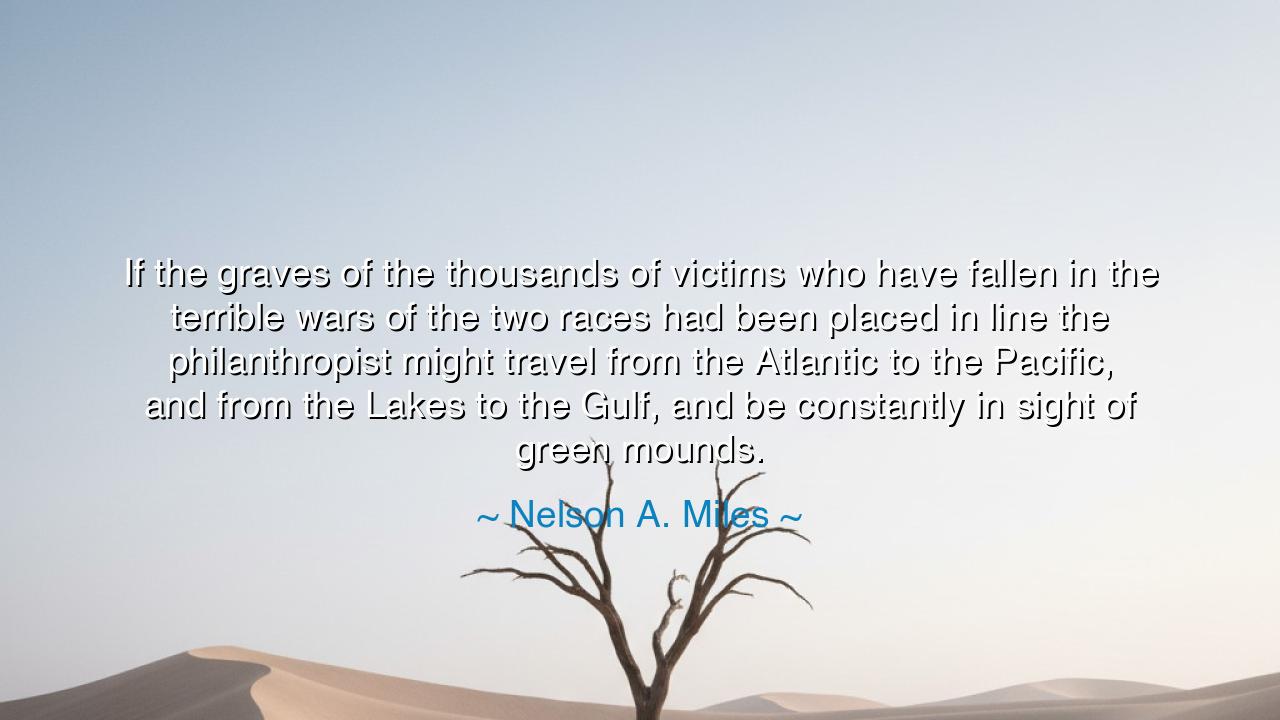
If the graves of the thousands of victims who have fallen in the
If the graves of the thousands of victims who have fallen in the terrible wars of the two races had been placed in line the philanthropist might travel from the Atlantic to the Pacific, and from the Lakes to the Gulf, and be constantly in sight of green mounds.






Nelson A. Miles, soldier and witness to the turbulent birth of a nation’s westward expansion, once spoke with solemn gravity: “If the graves of the thousands of victims who have fallen in the terrible wars of the two races had been placed in line the philanthropist might travel from the Atlantic to the Pacific, and from the Lakes to the Gulf, and be constantly in sight of green mounds.” His words are not the boasting of conquest, but the lament of one who saw clearly the immense cost of conflict. In this image, he paints a harrowing vision of graves stretching across a continent, unbroken, endless—a silent testimony to the destruction wrought by human pride, fear, and division.
The origin of these words lies in the bitter wars between Native American tribes and the expanding United States during the nineteenth century. Miles himself commanded troops in these campaigns, yet unlike many who glorified conquest, he acknowledged the profound tragedy of the struggle. By speaking of “the two races,” he did not erase the injustice; rather, he sought to show the staggering price paid by both sides. The land, vast and beautiful, became soaked with blood, and its prairies and hills dotted with the green mounds of those who would never rise again.
The ancients knew the weight of such imagery. Thucydides, chronicler of the Peloponnesian War, once wrote that war is a violent teacher, stripping men of reason and nations of compassion. In Miles’ vision, the long trail of graves is itself a teacher, a grim monument that could stretch from sea to sea, warning future generations of the futility of violence. Where marble monuments may deceive with glory, these humble mounds testify only to loss.
History gives us many such testaments. After the American Civil War, cemeteries multiplied across the land, each one a reminder that the dream of unity had been purchased in blood. Visitors to Gettysburg, even decades later, spoke of the overwhelming silence of the graves. Miles’ image of a line of mounds across the continent is a vision even more haunting, for it suggests that war between peoples leaves no region untouched, no community unscarred. The earth itself becomes a graveyard, and the road of the philanthropist becomes a pilgrimage through sorrow.
His words also contain a rebuke to false triumph. For many of his contemporaries spoke of “progress,” of “manifest destiny,” as though the deaths of thousands were mere stepping stones toward empire. Miles instead urges us to look upon the mounds—not as statistics or necessary sacrifices, but as lives, as fathers, mothers, sons, and daughters whose stories ended in silence. He reminds us that the true cost of war is measured not in land gained, but in lives lost.
The lesson is profound: never forget the human cost of conflict. War, once begun, stretches far beyond the battlefield. It leaves lines of graves that could encircle the earth, each mound a silent accusation, each patch of grass a testimony that peace was not chosen soon enough. To glorify conquest without remembering these mounds is to deceive ourselves and dishonor the dead.
Practically, this means striving for peace wherever possible in our own lives and communities. It means respecting those who differ from us, listening before striking, and seeking reconciliation before resentment hardens into hatred. For if conflict is allowed to grow unchecked, the graves will once again multiply, and the philanthropist—or the mourner—will have no road to travel but one bordered by sorrow.
Thus, Nelson A. Miles’ words endure as a timeless admonition: across this wide land, the dead already speak to us through their silence. May we listen to them. May we learn that the price of hatred is too great, that the trail of graves is too long, and that the truest victory is not to conquer, but to prevent the mound from being raised at all.






AAdministratorAdministrator
Welcome, honored guests. Please leave a comment, we will respond soon